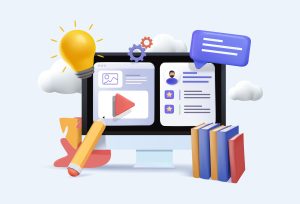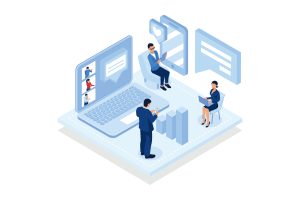A little healthy competition goes a long way to boosting employee engagement and developing your organisation’s learning culture. A learning management system (LMS) with gamified learning functionality uses rewards such as pop-up points and badges, as well as leaderboards, to spark interest in learning and reward employees who complete courses and activities.
It’s human nature to be competitive – whether you want to best a friend or colleague in a test, become the family Monopoly champion, or beat your own fastest time for a 5km run. So it makes sense to add competitive elements to your learning programmes and activities; a technique known as ‘gamification’.
Gamified learning rewards individuals with points, achievements, badges, progress bars and level completion, and, crucially, makes these achievements visible to other ‘players’ – learners – to encourage them to take part, too. Gamification helps to make learning more enjoyable, as well as increasing engagement and completion rates – helping your L&D team deliver tangible business results.
- What is a gamified learning platform?
- What is the difference between a learning platform and a gamified learning platform?
- Three top-tier features of a gamified learning platform
- How does gamification of a learning platform support employee development?
- Are gamified learning platforms effective?
- What is the main objective of gamified learning platforms?
What is a gamified learning platform?
Your e learning platform itself needs to have suitable features that allow you to apply these gaming principles in non-gaming contexts.
A gamified learning platform is a learning and development tool – a piece of software – that incorporates various gaming elements to enhance the learning experience.
By integrating gaming mechanics like points, badges, and leaderboards, it transforms the traditional learning process into an engaging and interactive adventure. This approach motivates learners, fosters a sense of achievement, and promotes active participation. Learners can track their progress, compete with peers, and receive instant feedback, all while consuming (and retaining) relevant content.
Gamified learning platforms have proven to be effective in academic settings and for professional development, making learning enjoyable and effective simultaneously.

What is the difference between a learning platform and a gamified learning platform?
A learning platform is a broad term for any digital software that facilitates educational content delivery, monitoring and reporting. In contrast, a gamified learning platform goes a step further by incorporating gaming elements into the learning experience.
Gamification in eLearning fosters a deeper understanding of the subject matter due to higher engagement and, consequently, higher knowledge retention rates. While both platforms aim to support learning, the gamified version uses game mechanics to create a more immersive learning environment.
Three top-tier features of a gamified learning platform
1. Gamified learning platforms offer visual learning journeys
Ciphr LMS’s learning journeys incorporate gamified elements – such as level completion, locked levels, and progress charts – to nudge learners along their journey. This visual presentation enhances the learning experience, and offers additional benefits, including:
- Improved comprehension: visuals help learners grasp complex concepts more easily, as they provide a tangible representation of theoretical ideas
- Increased engagement: visual elements capture learners’ attention and maintain their interest, leading to higher motivation and increasing active participation
- More inclusive practice: visual learning journeys can be complemented with audio and text-based modules, offering learners with diverse learning needs the material they need
- Facilitates critical thinking: visualisation in learning encourages learners to assess and analyse information, improving problem-solving skills and encouraging critical thinking
- Breaks down language barriers: removing the need to understand colloquialisms, or a language at a business-proficient level, helps multilingual learners understand the training material more deeply
2. Bring your brand to life with customisation
Each learning journey uses your brand’s graphics, colours, and font. Your gamified learning platform truly feels a part of your organisation, reinforcing your brand identity and creating a consistent experience.
Customisation in your gamified learning platform can be applied in a few ways:
- Branded rewards: incorporate branded badges, certificates, or virtual rewards that learners can earn as they progress, reinforcing your brand’s presence
- Interactive challenges: create gamified challenges that include your products or services, encouraging learners to apply their knowledge in practical scenarios
- Surveys and feedback: collect feedback from learners on the platform’s look and feel, and gather insights on what elements need improvement – or which are most popular
3. Gaming elements you can apply to all learning activities
You can apply various gaming mechanisms to all learning activities to make them more engaging:
- Pop-up reward points: earn points for each completed activity
- Leaderboards: show and share learning progress, helping to foster a learning culture and motivating learners to strive for higher achievements
- Customisable badges: encourage learners to complete learning activities aligned to your organisation’s goals and values, and instil a sense of accomplishment by rewarding them with customised badges
- Progress tracking: provide visual progress indicators, showing learners how far they’ve come and what’s left to accomplish
- Social learning: encourage teamwork and collaboration by incorporating group activities or discussions
How does gamification of a learning platform support employee development? Gamified learning rewards individuals with points, achievements, badges, progress bars, and level completion, and makes these achievements visible to other ‘players’ (learners) — encouraging them to take part, too.
Gamification makes learning more enjoyable while increasing engagement and completion rates – helping your L&D team deliver tangible business results, and instilling a sense of achievement and accomplishment in your employees.
Knowledge retention is also improved when a learner actively engages with learning material, making your training activities more effective in the long and short term.
However, there are some less-obvious ways a gamified learning platform can support employee development:
- Motivation and goal setting: gamification helps employees set and achieve learning goals: the intrinsic nature of gamification is having a clear objective to reach, and developing this habit can prove beneficial. Employees are incentivised to complete courses, modules, or challenges to earn points, badges, or other rewards, which boosts their motivation to learn and grow, and can develop their intrinsic motivation
- Active learning and skill development: gamified learning platforms contain many interactive activities, simulations, and scenarios that require employees to apply their knowledge and skills actively. This experience-based learning makes the learning process more effective and practical, and helps to effectively develop critical skills
- Retention and effective recall: gamified learning activities leverage repetition and will often require the learner to recall recent findings, which helps improve information retention and makes it easier to recall learnings. Gamified learning platforms use repetition techniques and quizzes to reinforce key concepts, aiding long-term knowledge retention and reducing the need (and cost) for repeated training
- Positive experiences create ‘return learners’: gamification creates a positive and enjoyable learning experience for employees, reducing the perception of learning as a tedious task or ‘tickbox exercise’. Employees are more likely to invest time in developing their skills and knowledge if they know it’s an enjoyable commitment of their time
Are gamified learning platforms effective?
Gamified learning can be effective in workplace learning in many ways. From improved knowledge retention to a more engaged employee training experience, there are many metrics you may want to consider when assessing how effective your gamified learning approach is. Practical ways to analyse the performance of your gamification include comparing learner engagement levels, testing knowledge retention (quizzes are a fun way to do this), and reviewing overall completion rates. Increased metrics in any or all of these datasets can indicate a positive performance of your gamified learning activities.
What is the main objective of gamified learning platforms?
The main objective of gamification in learning is to keep learners engaged with training activities while encouraging them to complete the course. Arguably, the goal of gamification is to make learning fun, and, while it easily achieves that, it is also an effective way to enhance a learner’s understanding of a topic without adding more content (or costs).
Related: Realising your ‘people potential’ through skills gap analysis >
Are you game for gamified learning?
If a gamified learning platform for your workplace training seems like it would be a good fit for your employees and your business, Ciphr may have the solution that’s right for you. Request a demonstration to experience how gamifying your training will boost your business, or download our brochure to learn more.
If you’re still in the exploratory stages of your gamification journey, these articles might be of interest:
- What are the benefits of eLearning gamification?
- How to maximise user engagement on your e learning platform
- The A– Z of eLearning terminology
- Finding the right eLearning content: which formats and sources work best?

